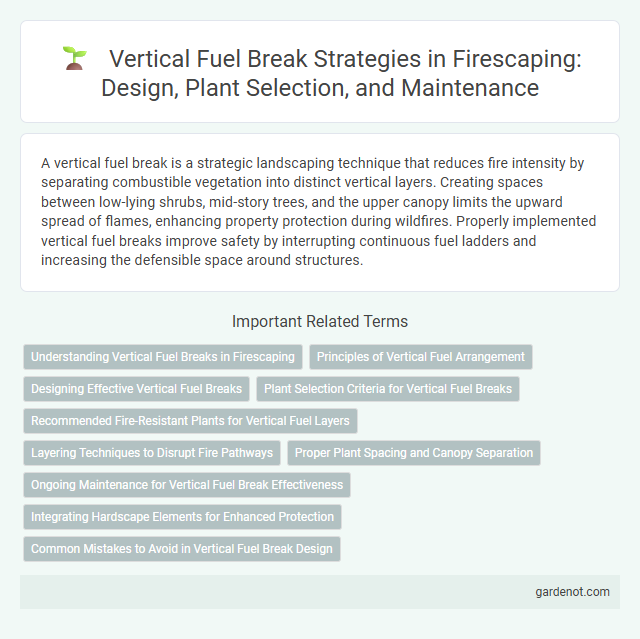A vertical fuel break is a strategic landscaping technique that reduces fire intensity by separating combustible vegetation into distinct vertical layers. Creating spaces between low-lying shrubs, mid-story trees, and the upper canopy limits the upward spread of flames, enhancing property protection during wildfires. Properly implemented vertical fuel breaks improve safety by interrupting continuous fuel ladders and increasing the defensible space around structures.
Understanding Vertical Fuel Breaks in Firescaping
Vertical fuel breaks in firescaping involve creating a staggered arrangement of vegetation layers to prevent flames from climbing from ground fuels to tree canopies. By removing or reducing ladder fuels such as low branches and shrubs, vertical fuel breaks reduce the risk of crown fires and enhance fire control efforts. Implementing these breaks strategically can significantly lower the intensity and spread of wildfires in forested and residential areas.
Principles of Vertical Fuel Arrangement
Vertical fuel breaks reduce fire intensity by creating layers of vegetation with varying heights, limiting the vertical continuity of flammable material. Principles of vertical fuel arrangement emphasize spacing out shrubs, grasses, and tree canopies so flames cannot easily climb from ground fuels to overstory crowns. Maintaining minimum vertical clearances between fuel layers disrupts fire's upward movement and protects structures from crown fires.
Designing Effective Vertical Fuel Breaks
Designing effective vertical fuel breaks requires strategically layering vegetation to reduce fire intensity by interrupting the vertical continuity of fuels. Implementing vegetation stratification, such as maintaining low shrubs and eliminating ladder fuels like small trees or tall grasses, minimizes fire's upward spread from ground to canopy. Incorporating fire-resistant plant species and ensuring adequate spacing between vegetation layers enhances control over fire behavior and improves overall landscape resilience.
Plant Selection Criteria for Vertical Fuel Breaks
Plant selection criteria for vertical fuel breaks prioritize species with high moisture content, low resin or oil concentrations, and minimal litter accumulation to reduce fire intensity. Drought-tolerant, fire-resistant plants that create physical separation between ground and canopy fuels aid in interrupting vertical fire spread effectively. Choosing native or adaptive species with sparse canopy structures and low growth rates enhances fuel break longevity and minimizes maintenance needs.
Recommended Fire-Resistant Plants for Vertical Fuel Layers
Recommended fire-resistant plants for vertical fuel layers in firescaping include low-growing succulents like sedum and creeping thyme, which retain moisture and reduce flammability. Mid-level shrubs such as California lilac (Ceanothus) and manzanita offer dense, fire-resistant foliage that limits vertical flame spread. Incorporating native grasses like purple needlegrass further disrupts fuel continuity while enhancing landscape resilience against wildfires.
Layering Techniques to Disrupt Fire Pathways
Layering techniques in vertical fuel breaks involve strategically arranging vegetation at multiple heights to interrupt fire spread from ground level to the canopy. By creating discontinuities between surface fuels, ladder fuels, and overstory layers, these methods reduce the vertical continuity of combustible material, minimizing fire intensity and slow progression. Effective vertical fuel breaks combine thinning, pruning, and selective planting to establish spatial separation that disrupts fire pathways and enhances landscape resilience.
Proper Plant Spacing and Canopy Separation
Proper plant spacing and canopy separation are crucial components of an effective vertical fuel break in firescaping, preventing fire from climbing from ground-level vegetation to tree canopies. Maintaining at least 10 feet between the tops of shrubs and lower branches of trees reduces flame transfer and slows fire spread. Strategic pruning and selective planting create defensible spaces by interrupting vertical continuity of fuels.
Ongoing Maintenance for Vertical Fuel Break Effectiveness
Ongoing maintenance of vertical fuel breaks is critical to sustaining fire resilience and minimizing fire spread in high-risk areas. Regular removal of ladder fuels, dead vegetation, and invasive species ensures the vertical fuel break remains intact and effective in interrupting flame pathways. Consistent inspection and targeted pruning enhance the structural integrity of the break, maintaining its capacity to reduce canopy fire intensity and protect surrounding ecosystems.
Integrating Hardscape Elements for Enhanced Protection
Integrating hardscape elements such as stone pathways, patios, and retaining walls creates effective vertical fuel breaks that slow fire spread and reduce combustible vegetation near structures. These non-flammable barriers disrupt continuous fuel layers, enhancing defensible space and protecting properties from wildfires. Strategically placing hardscape features within the landscape design optimizes fire resistance while maintaining aesthetic appeal.
Common Mistakes to Avoid in Vertical Fuel Break Design
Vertical fuel breaks often fail due to improper spacing between fuel layers, which allows fire to easily climb from surface fuels to the canopy. Neglecting to remove ladder fuels such as shrubs and small trees compromises the break's effectiveness by providing continuous ignition sources. Overlooking local topography and prevailing wind patterns can result in breaks that are ineffective during extreme fire conditions, undermining fire containment efforts.
Vertical fuel break Infographic

 gardenot.com
gardenot.com